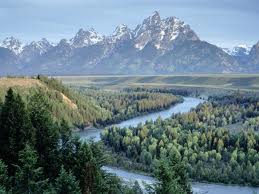We left Yellowstone and drove to Grand Teton National Park (only about 10 miles away), by way of the John D. Rockefeller Jr. Memorial Highway. The country around Jackson Hole is a magnificent landscape of buckrail fences, grassy plains, snow-covered mountains, and the meandering Snake River. I don’t remember much of that visit other than the scenery itself. Having made a resolution to do whatever “touristy” stuff was available wherever we went, we signed up for our first white water rafting experience. It was quite a day and quite a ride! The rafts were large, inflatable army surplus tubes which once upon a time, possibly during a war, might have been constituent parts of a pontoon bridge, but now served admirably to float us quite rapidly down the white water of the Snake River. Along the way, perched in a tree, I spotted my first bald eagle. As the ride down the Snake River took the better part of a day, we also stopped along the shore for food and refreshments, before resuming our trip on the current of the rapidly flowing river. Josh, who was all of five at the time, thought it great fun, particularly as he was allowed to “steer” the raft with about a dozen people on it. The rest of us just held on for dear life.
While in Wyoming, we visited other tourist attractions, among them the town of Cody, which is named after Buffalo Bill Cody, one of its founders, and is close (as distances go out West) to where General Custer’s 7th Cavalry was wiped out by Sitting Bull. The most famous animal in the area is neither the horse nor the bison, but the jackalope, a curious mix of jack rabbit and antelope. It seems to have the body of a large rabbit and carries a full set of antlers. Although quite shy—it is never seen, day or night—it appears on many postcards sold in the souvenir shops of the area. As a matter of fact, it is in the buying and selling of one of these postcards that Josh’s entrepreneurship first manifested itself when he sold one of these jackalope postcards to another boy for five cents less than it had cost him, and was as proud of the transaction as he might have been had he actually made a profit on it.
The only part of the trip that was thoroughly unhappy was when we traveled through the Rosebud Indian Reservation and at least one other reservation. It is possible that there are bleaker places on the face of the Earth, Siberia comes to mind, but I’ve never seen any. The reservations that we saw had not a tree among them, just unending scrub grass, unfit to feed anything, and no shade whatsoever. The homes of the people living there were small, some of them with corrugated steel roofs. The men we saw were either motionless in the hot sun, or staggered around in a drunken daze. I don’t want to give the impression that I’m some kind of teetotaler, but the combination of obvious poverty, lack of trees, and drunkenness was a completely dispiriting sight. There were no attractions, no shops, nothing to see, do or buy. These “reservations” seemed a purgatory to which lost souls had been condemned and exiled, while they waited for almost anything that might be different or better, and we guiltily left it all behind us as quickly as possible.

